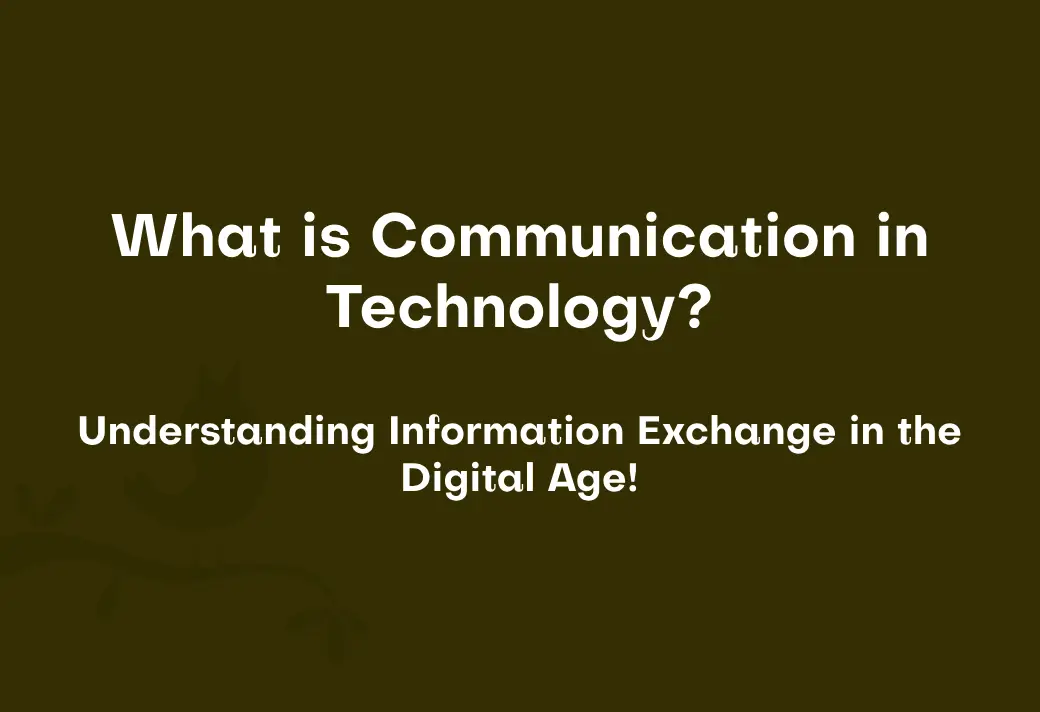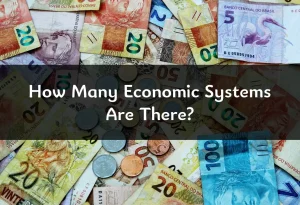In today’s digital age, communication has become easier and faster than ever before. Thanks to the advancement of technology, information can now be exchanged at lightning speed, breaking down barriers of distance and time. From traditional methods such as letters and phone calls to more modern forms like emails and social media, technology has revolutionized the way we communicate with one another.
In this article, we will delve into the world of communication in technology, exploring its various forms and how it has impacted our lives. We will take a closer look at how technology has facilitated the exchange of information, allowing us to connect with people from all over the world and share ideas and knowledge.
From personal interactions to global communication, technology has truly transformed the way we communicate, and it continues to shape and evolve the way we interact with one another. Join us as we dive into this fascinating topic and uncover the endless possibilities that technology brings to the world of communication.
Earn a certificate in your dream career for an affordable price at IAP Career College today!
Definition of communication in technology
Communication in technology refers to the process of transmitting and exchanging information through various technological mediums. It involves the transfer of data, messages, or signals between individuals or devices, enabling effective and efficient information sharing.
In the digital age, communication in technology has become increasingly prevalent and essential for personal, professional, and societal interactions. It encompasses a wide range of communication channels, such as emails, instant messaging, video conferencing, social media platforms, and telecommunications networks.
Through these technological advancements, communication has become faster, and more accessible, and has transcended geographical barriers, allowing individuals from different parts of the world to connect and exchange information seamlessly. The evolution of communication in technology has significantly impacted our lives, transforming the way we communicate, collaborate, and access information, shaping our interconnected digital society.
Evolution of communication with technology
Over the years, the evolution of communication with technology has revolutionized the way we interact and exchange information. With the advent of the internet, communication has transcended traditional boundaries, enabling instant and global connectivity. The development of communication technologies such as smartphones, social media platforms, and email systems has further enhanced the speed and efficiency of information exchange.
These advancements have not only bridged the gap between individuals and communities but also facilitated the dissemination of knowledge and ideas on a scale never seen before. Additionally, the integration of communication technologies into various industries has streamlined processes, improved collaboration, and fostered innovation. As technology continues to advance, the future of communication holds endless possibilities, paving the way for even more efficient and immersive forms of information exchange.
From Ancient Beginnings to the Information Age:
From ancient beginnings marked by smoke signals and hand gestures, communication has undergone a remarkable transformation through technology. Early inventions like the printing press and telegraph laid the groundwork for faster information exchange, but the true revolution came with the dawn of the Information Age. The internet’s emergence shattered geographical and social barriers, ushering in an era of instant global connectivity and laying the foundation for the diverse communication landscape we experience today.
The Internet: A Revolution in Connectivity:
The emergence of the internet stands as a pivotal moment in the history of communication, marking a true revolution in connectivity. Before its arrival, information exchange was often slow, geographically limited, and bound by specific channels.
The internet, however, shattered these barriers, fostering instantaneous and global connections. Individuals, organizations, and even entire nations are now able to exchange information seamlessly, fostering collaboration, knowledge sharing, and social interaction on an unprecedented scale. It is through this revolutionary power of connectivity that the internet has fundamentally reshaped the way we communicate in the digital age.
Beyond Traditional Boundaries: How Technology Connects Us:
In the realm of communication, technology has transcended the limitations of physical space and social barriers. Before the digital age, geographical distance and social constructs often hindered interactions. However, the advent of communication technologies has ushered in a paradigm shift, enabling individuals to connect and engage regardless of their physical location or social circles.
Through tools like social media platforms, video conferencing, and messaging applications, individuals can now forge connections, share experiences, and build communities that transcend geographical boundaries and social norms. This ability to connect beyond traditional limitations has fostered a more interconnected and globalized society, shaping the very fabric of social interaction in the digital age.
Speed, Efficiency, and Innovation: The Driving Forces of Communication Evolution:
The relentless pursuit of speed, efficiency, and innovation has served as the driving force behind the remarkable evolution of communication technology. Early advancements aimed to expedite information exchange, transitioning from the slow pace of postal mail to the relative swiftness of the telegraph.
As technology progressed, the focus shifted towards efficiency, fostering methods like email and instant messaging that streamlined communication processes. However, the quest for innovation has continually pushed the boundaries, leading to the development of diverse communication tools, such as video conferencing and social media platforms.
These advancements have not only accelerated the exchange of information but have also fostered collaboration, knowledge dissemination, and even entertainment on a global scale, highlighting the profound impact of these driving forces on various aspects of our lives.
Role of the internet in communication
The role of the internet in communication is undeniably pivotal in today’s society. It serves as a vast network that connects individuals, organizations, and countries across the globe. The Internet enables real-time communication, allowing people to exchange information instantly through various channels such as email, instant messaging, and video conferencing.
This accessibility has not only facilitated personal and professional interactions but has also transformed the way businesses operate and collaborate. Moreover, the internet provides a platform for individuals to express their thoughts and opinions through social media platforms, blogs, and online forums, fostering a sense of global community and facilitating the dissemination of ideas on a massive scale.
Additionally, the internet has democratized access to information, allowing individuals to research, learn, and stay informed on a wide range of topics. The internet’s role in communication cannot be undermined, as it continues to shape and redefine the way we connect, collaborate, and interact in the digital age.
From Geographical Barriers to Global Connections: The Internet’s Transformative Impact:
The internet has had a transformative impact on global connectivity, dissolving geographical barriers that once limited communication. Before its widespread adoption, physical distance significantly constrained the ability of individuals and organizations to interact, collaborate, and share knowledge.
The internet, however, has created a virtual world where geographical location holds little significance. Its reach extends beyond borders and continents, allowing for seamless connections between individuals, businesses, and institutions across the globe.
This unprecedented level of connectivity has enabled the exchange of ideas, fostered cultural understanding, and established a truly global network where distance is no longer an insurmountable obstacle.
Beyond Instant Messaging: The Diverse Channels of Communication Enabled by the Internet:
The internet has profoundly expanded the channels of communication, moving far beyond the initial concept of instant messaging. While instant messaging revolutionized real-time text-based conversations, the internet now supports a rich landscape of communication methods.
Voice and video calls have collapsed the sense of distance, allowing for face-to-face interactions across continents. Email systems facilitate the exchange of formal documents and detailed messages.
Additionally, social media platforms foster communities based on shared interests, enable discussions and debates, and support multimedia sharing, creating a vibrant and multifaceted communication ecosystem within the digital sphere.
Empowering Individuals and Businesses: The Internet as a Platform for Interaction and Collaboration:
The internet has emerged as a powerful platform for both personal and professional interaction and collaboration. On a personal level, individuals can leverage social media platforms, email, and video calls to connect with friends, family, and acquaintances across the globe.
This fosters a sense of community and belonging, transcending geographical limitations. In the professional realm, the Internet facilitates seamless communication and collaboration between colleagues, partners, and clients across different locations.
Businesses can utilize various online tools for project management, real-time document sharing, and virtual meetings, fostering a more efficient and effective work environment.
By empowering individuals and businesses to connect and collaborate, the internet has fundamentally reshaped the way we interact and work in the digital age.
Different forms of digital communication
In addition to the internet, there are numerous other forms of digital communication that have become integral to our lives. Mobile devices, such as smartphones and tablets, have revolutionized communication by providing instant and convenient access to various communication tools. Text messaging has become a popular method of communication, allowing individuals to send short messages to one another easily.
Mobile applications, or apps, have further expanded the possibilities of digital communication, enabling users to communicate through voice and video calls, share multimedia content, and participate in virtual meetings or conferences. Social media platforms have also emerged as significant digital communication tools, allowing individuals to connect, share information, and engage in discussions with a wide network of friends, colleagues, and even strangers.
These platforms have given rise to new forms of communication, such as status updates, photo sharing, and live streaming, enabling individuals to express themselves in creative and interactive ways. Overall, the various forms of digital communication have transformed the way we interact, share information, and build relationships, bringing people closer together in the digital realm.
Beyond the Desktop: Mobile Devices and the Rise of On-the-Go Communication:
The emergence of mobile devices, particularly smartphones and tablets, has ushered in a new era of “on-the-go” communication, fundamentally altering the way we interact and exchange information.
These ubiquitous devices have transcended the limitations of desktop computers, enabling users to stay connected and engaged in real time, regardless of their physical location.
Whether it’s sending a quick text message, participating in a video call, or accessing social media platforms, mobile devices empower individuals to communicate seamlessly and conveniently, fostering a constant sense of connection and information access within the ever-evolving digital landscape.
Connecting Through Networks: Social Media as a Platform for Global Interaction and Expression:
Social media platforms have emerged as potent spaces for global interaction and expression, revolutionizing the way individuals connect with one another. These platforms offer a forum for individuals to share thoughts, ideas, and experiences, fostering a sense of community that transcends geographical borders and traditional social circles.
They empower users to engage in discussions, debates, and collaborations with a diverse range of individuals from around the world, contributing to the exchange of knowledge and cultural understanding.
Furthermore, social media platforms provide avenues for self-expression, allowing individuals to document their lives, showcase creativity, and advocate for causes close to their hearts, demonstrating the power of these networks in shaping personal narratives and social movements.
Evolving Forms of Engagement: Status Updates, Photo Sharing, and Live Streaming in the Digital Age:
The landscape of communication within social media platforms is constantly evolving, with new forms of engagement emerging alongside established practices. Beyond traditional text-based exchanges, platforms now offer avenues for creative and interactive expression.
Status updates, once primarily textual, have evolved to encompass multimedia elements like pictures, videos, and emojis, allowing for a richer and more nuanced portrayal of experiences and emotions. Photo sharing has become a cornerstone of social media, fostering visual storytelling and fostering connections around shared interests and experiences.
The rise of live streaming adds another dimension, facilitating real-time interactions and fostering a sense of community through shared experiences, from attending virtual concerts to engaging in live discussions. These diverse forms of engagement highlight the dynamic nature of communication in the digital age, where individuals are constantly exploring new ways to express themselves and connect with others.
Impact of social media on communication
The widespread adoption of social media platforms has had a profound impact on communication in the realm of technology. Social media has transformed the way we connect and interact with others, providing new channels for sharing information, thoughts, and experiences. It has facilitated instant and global communication, breaking down geographical barriers and allowing people to connect with individuals from different parts of the world.
Additionally, social media has given individuals a platform to express their opinions and engage in discussions on various topics, leading to the democratization of communication. However, it is important to acknowledge that social media has also introduced challenges in communication, such as the spread of misinformation and the potential for online harassment. These factors highlight the complex and multifaceted nature of the impact of social media on communication in technology.
Benefits of technology in communication
Technology has revolutionized communication by offering numerous benefits in various aspects of our lives. One of the primary advantages is the efficiency and speed with which information can be transmitted. With the advent of email, instant messaging, and video conferencing, individuals and organizations can exchange messages and collaborate in real time, regardless of their physical location.
This has significantly reduced the limitations imposed by distance and time zones, enabling seamless global communication and fostering international collaborations. Furthermore, technology has expanded the modes of communication beyond traditional text-based mediums.
The integration of audio and video capabilities allows for richer and more immersive interactions, enabling individuals to convey emotions, expressions, and non-verbal cues. These advancements in communication technology have not only improved the efficiency of information exchange but also enhanced the overall quality and effectiveness of interpersonal and professional interactions.
Challenges in technology-mediated communication
In the world of communication in technology, there exist several challenges in technology-mediated communication that warrant attention. One such challenge is the lack of non-verbal cues and context in digital interactions.
Unlike face-to-face communication, technology-mediated communication often lacks the ability to convey tone of voice, facial expressions, and body language. This can lead to misunderstandings, misinterpretations, and conflicts, as the intended meaning of a message may be misconstrued or lost entirely.
Additionally, the asynchronous nature of many digital communication platforms can contribute to delays in response times, further exacerbating miscommunications. Furthermore, issues such as connectivity problems, technical glitches, and compatibility constraints can hinder the smooth flow of communication, leading to frustration and reduced productivity.
Hence, it is crucial for users to be aware of these challenges and develop strategies to overcome them in order to effectively navigate the realm of technology-mediated communication.
Ethical considerations in digital communication
In the realm of communication in technology, ethical considerations play a pivotal role in shaping the way individuals interact and exchange information. With the widespread use of digital communication platforms, it becomes essential to address ethical implications arising from these technologies. One ethical concern involves privacy and data protection.
In an era where personal information is constantly shared and stored digitally, individuals must be cautious about how their data is collected, used, and shared by various entities. Ensuring consent and implementing robust security measures are crucial to safeguard sensitive information.
Additionally, the issue of online harassment and cyberbullying has gained prominence, highlighting the need for establishing guidelines and promoting respectful and inclusive digital communication environments.
Furthermore, the dissemination of false information, commonly referred to as “fake news,” poses a significant ethical challenge in the digital landscape, as it can manipulate public opinion and have detrimental effects on societies.
Combatting misinformation and promoting digital literacy is essential in cultivating ethical digital communication practices. Overall, addressing these ethical considerations is imperative in fostering a responsible and inclusive digital communication ecosystem.
Communication technology in education
In the context of education, communication technology has revolutionized the way information is exchanged and accessed by students and educators alike. With the advent of online learning platforms, virtual classrooms, and interactive digital resources, communication technology has opened up new avenues for both synchronous and asynchronous learning.
Through online discussions, video conferences, and collaborative tools, students can engage with their peers and teachers, fostering a sense of community and enhancing the learning experience. Moreover, communication technology enables students to access a wealth of educational materials and resources from around the world, breaking down geographical barriers and expanding their knowledge base.
This integration of communication technology in education not only enhances the efficiency and effectiveness of teaching and learning processes but also prepares students for the digital world they will navigate in their future careers. Students develop critical digital literacy skills, such as information evaluation and online etiquette, enabling them to be responsible and informed global citizens.
From Traditional Classrooms to Online Learning Platforms: Redefining Education through Technology:
The advent of communication technology has ushered in a paradigm shift in the educational landscape, transforming traditional classrooms into dynamic online learning platforms. This transition transcends mere physical space, fundamentally redefining the learning experience.
Online platforms offer asynchronous and synchronous learning opportunities, catering to diverse learning styles and schedules. Students can access a vast array of educational resources from around the globe, fostering independent exploration and knowledge acquisition.
Furthermore, communication tools integrated into these platforms facilitate collaboration and interaction between students and educators, fostering a sense of community and promoting active engagement in the learning process.
These revolutionary changes, powered by communication technology, are redefining education, paving the way for a more personalized, flexible, and globally connected learning environment.
Connecting Learners Globally: Fostering Collaboration and Community through Communication Tools:
The ubiquitous nature of communication technology has transformed the educational landscape, fostering collaboration and community building among students and teachers across geographical boundaries.
Online learning platforms equip educators with a plethora of communication tools, such as discussion forums, group projects, and real-time chat functions. These tools empower students to engage in interactive learning experiences, fostering critical thinking and problem-solving skills through collaborative activities.
Additionally, communication technology facilitates the formation of virtual communities, connecting students from diverse backgrounds and fostering a sense of belonging and shared purpose within the learning environment.
This increased interaction and collaboration, powered by communication technology, enriches the educational experience by promoting deeper understanding, peer-to-peer learning, and a sense of community within the globalized classroom.
Expanding Horizons: Accessing a World of Knowledge with Educational Resources:
Communication technology has profoundly expanded learning horizons, allowing access to a global wealth of knowledge and educational resources. No longer confined by the physical limitations of traditional libraries, students can now tap into vast online repositories, digital archives, and educational databases from anywhere in the world.
This democratization of access opens unprecedented opportunities for learners, particularly those in remote or underserved areas, to explore diverse subjects, gain new perspectives, and enrich their understanding.
As communication technology removes geographical boundaries, students can access information from leading institutions, engage with experts across the globe, and contribute to a dynamic and interconnected educational landscape.
Preparing for the Future: Developing Digital Literacy Skills for Responsible Global Citizenship:
In the face of a rapidly evolving technological landscape, communication technology plays a crucial role in equipping students with the necessary skills to navigate the digital world and become responsible global citizens.
By integrating the development of digital literacy within the educational experience, educators empower students to critically evaluate information, navigate online environments responsibly, and participate ethically in the digital sphere.
This includes fostering an understanding of information bias, responsible communication practices, and online etiquette. By cultivating these critical skills, communication technology paves the way for students to become responsible digital citizens who can actively contribute to a more informed and inclusive global society.
The future of technology and communication
With the rapid advancements in technology, the future of communication is poised for exciting possibilities. Emerging technologies such as artificial intelligence, virtual reality, and augmented reality are expected to revolutionize the way we interact and exchange information.
These technologies have the potential to create immersive and engaging communication experiences, allowing individuals to communicate and collaborate in virtual worlds or simulated environments. Moreover, the increasing integration of Internet of Things (IoT) devices and smart connectivity will further enhance communication capabilities, enabling seamless and instant communication across various platforms and devices.
Additionally, the development of 5G networks will significantly improve network speeds and reliability, enabling faster and more efficient communication, as well as facilitating the widespread adoption of Internet-based communication technologies.
In conclusion, the future of technology and communication holds immense potential for transforming the way we connect, collaborate, and share information, ushering in a new era of communication possibilities.
Conclusion: What is Communication in Technology?
In conclusion, the advancements in technology have revolutionized the way we communicate and exchange information. From traditional methods like letters and phone calls to the modern forms of social media and messaging apps, technology has made communication more convenient and accessible.
However, it is important to also recognize the potential negative impacts of technology on our personal interactions and society as a whole. As we continue to rely on technology for communication, it is crucial to strike a balance and use it responsibly to maintain genuine human connections.
FAQs
How has technology changed the way we communicate with each other in the modern world?
Technology has revolutionized communication by providing various platforms such as social media, instant messaging, video calls, and emails that enable us to connect instantly with people around the world. It has made communication faster, more convenient, and more accessible, allowing us to stay connected with others regardless of distance or time zones.
Additionally, technology has also changed the way we express ourselves through emojis, gifs, and other forms of digital communication, making interactions more engaging and expressive. Overall, technology has significantly enhanced the way we communicate in the modern world.
What are some examples of different forms of communication technology that are commonly used today?
Some common forms of communication technology used today include smartphones, email, social media platforms, video conferencing tools, instant messaging applications, and collaboration software. These technologies enable people to communicate and connect with others in real time, regardless of geographical location, making information sharing and collaboration easier and more efficient.
How has the rise of social media platforms impacted the way we share information and connect with others?
The rise of social media platforms has revolutionized the way we share information and connect with others by providing instant communication, global reach, and easily shareable content. It has made it easier for individuals to stay connected regardless of physical distance, facilitated the spread of information at a rapid pace, and allowed people to express their thoughts and opinions on a public platform.
However, it has also raised concerns about privacy, misinformation, and the impact of online interactions on mental health. Overall, social media has fundamentally changed the way we communicate and form relationships in the digital age.
What are some potential drawbacks or challenges associated with relying heavily on technology for communication?
Relying heavily on technology for communication can lead to decreased face-to-face interactions, potential misinterpretation of messages due to lack of non-verbal cues, increased distractions, privacy and security concerns, and over-dependence on devices. Additionally, technological glitches or outages can disrupt communication flow and cause hindrances in conveying messages effectively. Balancing technology with in-person interactions is crucial to maintaining meaningful relationships and ensuring clear and effective communication.
In what ways has technology facilitated global communication and connected people from different parts of the world?
Technology has revolutionized global communication by enabling instant messaging, video calls, and social media platforms that connect individuals worldwide. These tools have broken down physical barriers, allowing people to interact, collaborate, and share information in real time. Additionally, advancements like translation software make language differences less of a hindrance. This interconnectedness has fostered cultural exchange, business opportunities, and even social movements that transcend borders. Overall, technology has made the world more accessible, fostering understanding and unity among diverse populations.





